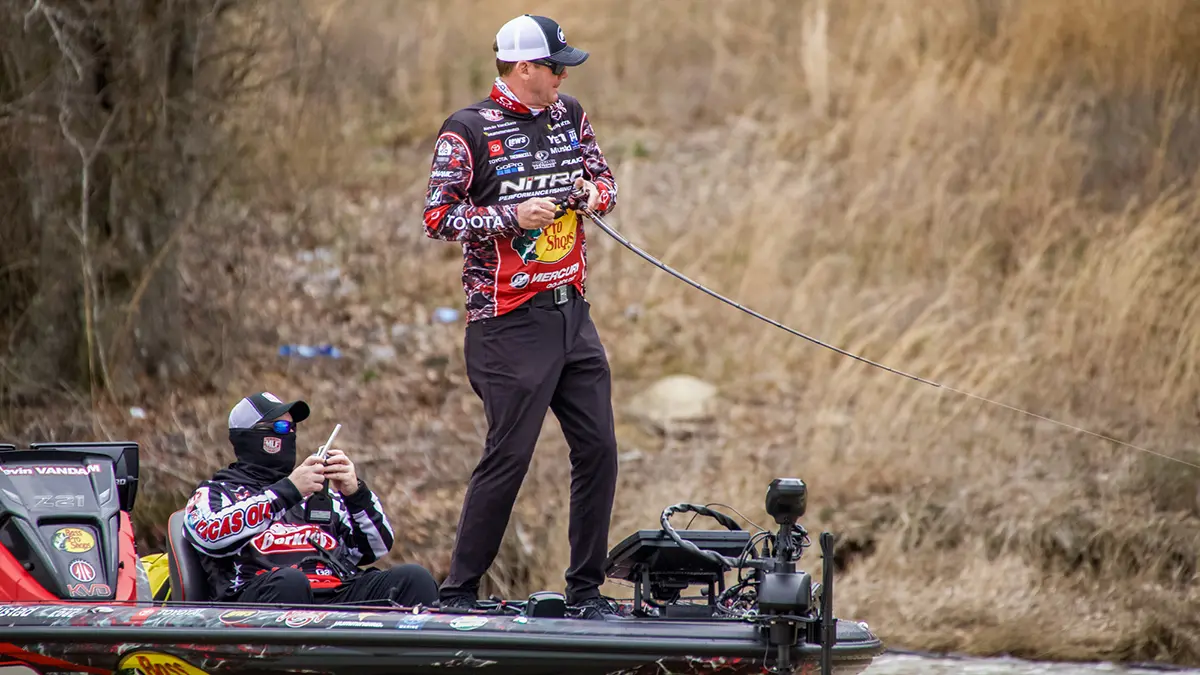Warning: Undefined variable $k in /home/nginx/domains/wired2fishcom.bigscoots-staging.com/public/wp-content/themes/understrap-child-0.6.0/functions.php on line 984
Warning: Undefined variable $k in /home/nginx/domains/wired2fishcom.bigscoots-staging.com/public/wp-content/themes/understrap-child-0.6.0/functions.php on line 987
Kevin VanDam looks forward to the days when summer melts away and the crisp weather of fall arrives. So do the largemouth bass.
When the days get shorter and the water gets cooler, the bass get hungry. This can lead to some of the best fishing of the year, VanDam told Wired2fish.com.
“Mid-September all the way through October is one of my favorite times to fish,” said VanDam, one of bass fishing’s all-time greats. “I’ve had some of my best days on the water in fall.”
Take it from the man. Don’t put your fishing gear away just yet. Follow VanDam’s advice and you still might experience some of your best bassin’ of the year.
DAYLIGHT SAVINGS
Length of day is the most important determinant for the fall pattern, VanDam said. “As the days get shorter, it triggers change,” he said.
There is no magic date or water temperature that goes along with that shift, though. “You can’t circle one date on the calendar and say that’s the time to go,” VanDam said. Instead, he looks for a 10-degree drop from average water temperatures on that body of water in the summer. He used the Ozarks reservoirs as an example.
“On those reservoirs, the average summer water temperatures stay in the low to mid 80’s,” he said. “When the water temperature drops into the mid 70’s, the fall pattern comes into play.”
WHAT TO EXPECT
As fall sets in, the baitfish move from the depths to shallower water. “Sometimes, it’s a gradual process. Other times, a weather event with heavy rain will bring a lot of fresh, cooler water into a system,” VanDam said. “That will trigger a big shad migration. “The baitfish will move into creek arms and you’ll see large balls of shad and lots of surface activity.”
That change is most evident on the upper reaches of a reservoir first. That’s where major tributaries enter the main body. The fall pattern will work its way down as fall progresses.
“Find the baitfish and you’ll find the bass,” VanDam said. “You have to know the habits of the dominant prey species in that body of water to be successful.”
It isn’t always shad. In some northern lakes, bluegills are often the main prey. In the southeast, blueback herring are dominant in some bodies of water.
WHERE TO LOOK
Baitfish often follow creek channels into shallower areas, then disperse on flats. VanDam likes to target isolated cover in a creek such as laydowns, a stump or a boat dock. However, the baitfish don’t necessarily relate to cover. Often, they will school up and just roam.
That’s when it can get fun. Often, bass will follow those schools of shad and will tear into them, sending frenzied baitfish scattering in all directions. “Fall fishing is all about shad.” VanDam said.

HOW TO CATCH THEM
Fall is also all about topwater fishing. VanDam loves to cast a Strike King Sexy Dawg topwater bait to reach surfacing activity. He helped design the bait to accommodate long casts and cover lots of water with its side to side action, which pros nickname “walking the dog.” He even came up with a Hard Knock version, so that the bass will not only see the commotion it creates but hear it as well.
He uses the 7-foot, 4-inch Lew’s signature series baitcasting rod he designed for Lew’s. It’s a medium-heavy rod with a fast tip, which VanDam said is ideal for long casts. He uses 40- to 50-pound braid to achieve an optimum retrieve and the Hard Knock version of the Sexy Dog so that bass will not only see the commotion but hear it as well.
When the bass aren’t quite as active, VanDam will go to his Strike King KVD Splash topwater plopper bait. He labels that topwater as more of a target-oriented lure, which he casts to isolated cover such as brush piles, rocky banks, riprap, or boat docks. “It’s a slower type of topwater, but you can keep it in the strike zone longer,” he said.
OTHER WINNING BAITS
Another bait that VanDam has always tied onto one of his rods in the fall is a square bill CrankBait. Bass can be finicky about keying on the size of the baitfish they are feeding on in the fall, to combat this VanDam likes to use his Strike King KVD 1.0 Square bill. That smaller bait “can be phenomenal” in the fall, he said.
He also casts spinnerbaits in autumn, though he often downsizes his offerings. He will go to a 3/8ths- or a 5/16th-ounce KVD Finesse spinnerbait, with smaller blades to again imitate the size of the baitfish. He will target channel-swing banks, mud flats and the back of creeks where the shad like to hang out.
HIT SNOOZE
Another advantage of fall fishing is that you don’t have to be out at the crack of dawn. In fact, the best shad activity often comes in the afternoon, VanDam said. “Especially later into fall, the shad seem to be more active when it warms up just a bit,” he said.
So, try fitting in a few more fishing trips before winter sets in. Sure, it’s busy with the hunting seasons, football and kids activities. However, the fish are waiting. Follow VanDam’s game plan, and you might catch your biggest bass of the year.












